Study on the Effect of Asphalt Static Conditions on the Tensile Properties of Acidic Aggregate Hydraulic Asphalt Concrete
Abstract
1. Introduction
- (1)
- Research was conducted to assess the static conditions affecting the tensile properties of asphalt concrete. Tensile tests were conducted under different static conditions, including 0 days, 10 days, 20 days, and 30 days, with the objective of analyzing the alterations in the tensile properties of the asphalt concrete under these varying static conditions.
- (2)
- To explore the influence of adhesion between aggregates and asphalt on tensile strength and suggest enhancement strategies, numerical simulations were performed using ABAQUS 2023. This study focused on scrutinizing the microlevel influencing factors, including coarse aggregate characteristics such as the aggregate gradation, coarse aggregate content, maximum particle size, and angular index. The tensile strength variations were compared under different influencing factors.
2. Materials and Methods
2.1. Materials
2.1.1. Asphalt
2.1.2. Coarse Aggregate
2.1.3. Fine Aggregates
2.1.4. Fillers
2.1.5. Anti-Stripping Agent
- (1)
- Good product performance: For ordinary granite, gneiss and other acidic aggregates, a mixed solution of anti-stripping agent and asphalt with a weight ratio of 0.2% to 0.4% has been found to significantly enhance adhesion. In order to meet the hydraulic asphalt concrete construction requirements, the anti-stripping agent parameter needs to be increased to 0.6% of the weight of asphalt to 1.2%. This is necessary in order to ensure the stability of the asphalt and acidic aggregate water.
- (2)
- Wide range of adaptation: SK-A asphalt concrete anti-stripping agent is not only suitable for hydraulic asphalt concrete construction but can also be applied to road asphalt concrete construction.
- (3)
- Good applicability: Solid particles at room temperature, easy to transport. Melting point of 60 °C, easily soluble in asphalt, easy to use. The boiling point is 230 °C, and the high-temperature performance and stability are excellent. The 130 °C asphalt can be sealed for storage for up to 30 days without any significant loss of adhesion.
- (4)
- Environmentally friendly: The product contains no volatile components and no pollution, and the construction process has a minimal impact on human health.
2.1.6. Grading
- (1)
- Properties of the raw materials, including asphalt, coarse aggregate, fine aggregate, and filler;
- (2)
- Aggregate grading;
- (3)
- Filler quantity, denoting the proportion of filler within the mineral composition;
- (4)
- The oil/stone ratio is defined as the ratio of the asphalt mass to the aggregate mass in the asphalt mixture.
- Pi—passage rate of sieve di, %;
- F—amount of filler with a particle size of less than 0.075 mm, %;
- dmax—maximum particle size of the mineral, mm;
- di—a certain sieve size, mm;
- d0.075—maximum particle size of the filler, 0.075 mm;
- r—grading index.
2.2. Method
2.2.1. Equipment and Conditions
- (1)
- Specimen preparation and specimen size: The asphalt mixture was processed into sizeable plate specimens measuring 12 cm × 6 cm × 25 cm. For each layer of the specimen, 105 impacts were performed using a Marshall standard hammer. Subsequently, after the plate specimens were naturally cooled, they were cut into 4 cm × 4 cm × 20 cm tensile specimens to determine their density and calculate their porosity. These cut specimens were then affixed to the tensile specimen chuck using high-strength adhesive, allowed to stabilize for 24 h, and subjected to temperature equilibration before testing.
- (2)
- Testing temperature: Maintained at 5 ± 0.5 °C.
- (3)
- Testing loading rate: Set at 1.0 mm/min.
- Rt—tensile strength, in MPa;
- εt—strain at maximum stress of the specimen, %;
- δt—axial tensile deformation, mm;
- P—specimen subjected to the axial maximum load, N;
- A—specimen section area, mm2;
- L—specimen axial side marking distance, mm.
- Et—tensile strength, MPa;
- Rt—a certain tensile stress, MPa;
- εt—strain at maximum stress of the specimen, %.
2.2.2. Ontological Relationships
2.3. Study of the 2D Model Interface Parameters
2.3.1. Interfacial Parameter Studies
2.3.2. Asphalt Mortar–Coarse Aggregate Interface Research
2.3.3. Asphalt Mortar–Asphalt Mortar Interface Research
2.4. Numerical Simulation
2.4.1. Comparison between 2D Models and Actual Working Conditions
2.4.2. Inversion of Interface Parameters
3. Results and Discussion
3.1. Tensile Test Results
3.2. Research on the Modulation of the Tensile Strength of Hydraulic Asphalt Concrete with an Acidic Aggregate
3.2.1. Effect of Coarse Aggregate Gradation on Tensile Strength
3.2.2. Effect of Coarse Aggregate Content on Tensile Strength
3.2.3. Effect of the Maximum Coarse Aggregate Size on the Tensile Strength
3.2.4. Effect of the Coarse Aggregate Prismatic Index on the Tensile Strength
- Increased Friction: Coarse aggregate particles with a high angular index exhibit larger contact areas with cementitious materials (e.g., asphalt) in the concrete, leading to enhanced bonding and friction, which contributes to the tensile strength of the asphalt concrete.
- Enhanced Cohesion: High angular index coarse aggregate particles can securely lock cementitious material, providing better cohesion and thus improving the tensile properties of asphalt concrete.
- Impact on Void Ratio: Coarse aggregate particles with a high angular index efficiently fill voids in the concrete, reducing the void ratio, enhancing the compactness, and strengthening the asphalt concrete.
- C—perimeter of coarse aggregate
- S—coarse aggregate area
4. Conclusions
- (1)
- Examination of the effect of the storage time on the mechanical properties revealed the following results: After 10, 20, and 30 days of resting, the tensile specimens not adulterated with the anti-stripping agent exhibited a decrease in tensile strength, from 1.711 MPa to 1.573 MPa, 1.073 MPa, and 0.914 MPa, respectively. In contrast, the tensile modulus increased from 83.24 MPa to 116.91 MPa. The tensile strength of the specimens containing the anti-stripping agent decreased from 1.723 MPa to 1.609 MPa, 1.324 MPa, and 1.294 MPa after 10, 20, and 30 days of rest, respectively, while the tensile modulus increased from 85.39 MPa to 113.79 MPa, 119.19 MPa, and 146.46 MPa, respectively. These results suggest that the addition of anti-stripping agents did not alter the decreasing trend in the tensile properties of asphalt concrete with a prolonged storage time.
- (2)
- Comparative analysis between the numerical simulation and physical tests revealed that the decrease in the tensile properties could be attributed to adjustments in the interface parameters of the asphalt mortar–coarse aggregate. The cohesion between the asphalt and aggregate decreased significantly from 5.375 MPa to 2.664 MPa over 30 days of resting, representing a 50% reduction. Additionally, the grading indices of the coarse aggregate and coarse aggregate contents and the maximum coarse aggregate particle size were found to influence the peak stress of asphalt concrete. An increase in the number of vertices of coarse aggregate led to a gradual decrease in the peak stress. In conclusion, reducing the grading index and maximum particle size of aggregates, decreasing the content of coarse aggregates, and favoring round and smooth aggregate shapes while reducing porosity were identified as measures to mitigate the adverse effects of the storage time on the adhesion of acidic aggregates to asphalt.
Supplementary Materials
Author Contributions
Funding
Institutional Review Board Statement
Informed Consent Statement
Data Availability Statement
Conflicts of Interest
References
- Min, W.; Heqing, Z.; Dongdong, C. Research and Application on Seepage Detection and Repair of Anti-Seepage System for Earth-Rockfill Dam with Asphalt Concrete Core; Science Publishing Group: New York, NY, USA, 2018. [Google Scholar]
- Feizi-Khankandi, S.; Mirghasemi, A.A.; Ghalandarzadeh, A.; Hoeg, K. Cyclic triaxial tests on asphalt concrete as a water barrier for embankment dams. Soils Found. 2008, 48, 319–332. [Google Scholar] [CrossRef]
- Wang, W.; HöEg, K. Cyclic Behavior of Asphalt Concrete Used as Impervious Core in Embankment Dams. J. Geotech. Geoenviron. Eng. 2011, 137, 536–544. [Google Scholar] [CrossRef]
- Soltani, A.S.; Litkouhi, S. Asphalt concrete core of the Meijaran dam in brief. Dam Eng. 2009, 20, 235–253. [Google Scholar]
- Zhang, Y.; HöEg, K.; Wang, W.; Zhu, Y. Watertightness, cracking resistance, and self-healing of asphalt concrete used as a water barrier in dams. Can. Geotech. J. 2013, 50, 275–287. [Google Scholar] [CrossRef]
- Jiang, L.I.; Ying, L.; Jianxin, H.E. Advances in construction technologies of roller compacted asphalt concrete core wall dams in Xinjiang. Adv. Sci. Technol. Water Resour. 2019, 39, 82–89. [Google Scholar]
- Gao, J.; Dang, F.; Ma, Z. Investigation for the key technologies of ultra-high asphalt concrete core rockfill dams. Soils Found. 2019, 59, 1740–1757. [Google Scholar] [CrossRef]
- Feizi-Khankandi, S.; Ghalandarzadeh, A.; Mirghasemi, A.A.; Hoeg, K. Seismic analysis of the garmrood embankment dam with asphaltic concrete core. Soils Found. 2011, 49, 153–166. [Google Scholar] [CrossRef]
- Wang, W.; Heg, K.; Zhang, Y. Design and performance of the Yele asphalt-core rockfill dam. Can. Geotech. J. 2010, 47, 1365–1381. [Google Scholar] [CrossRef]
- Wang, W. Developments in the design and construction of asphalt core dams. Int. J. Hydropower Dams 2010, 17, 83. [Google Scholar]
- Long, A.; Sun, X.; Yu, Z.; Zhang, B.; Zhang, G.; Huang, P.; Wang, J. Experimental study and mechanism analysis on the basic mechanical properties of hydraulic basalt fiber asphalt concrete. Mater. Struct. 2022, 55, 161. [Google Scholar] [CrossRef]
- Zhang, Y.; Wang, W.; Zhu, Y. Investigation on conditions of hydraulic fracturing for asphalt concrete used as impervious core in dams. Constr. Build. Mater. 2015, 93, 775–781. [Google Scholar] [CrossRef]
- Gao, L.; Jianyun, C. Seismic safety evaluation of large concrete dams. J. Hydraul. Eng. 2001, 32, 8–15. [Google Scholar]
- Chaabene, W.B.; Flah, M.; Nehdi, M.L. Machine learning prediction of mechanical properties of concrete: Critical review. Constr. Build. Mater. 2020, 260, 119889. [Google Scholar] [CrossRef]
- Zhang, Y.; Zhu, Y.; Wang, W.; Ning, Z.; Feng, S.; Heg, K. Compressive and tensile stress–strain-strength behavior of asphalt concrete at different temperatures and strain rates. Constr. Build. Mater. 2021, 311, 125362. [Google Scholar] [CrossRef]
- Khanna, R.; Datta, M.; Ramana, G.V. Influence of core thickness on stability of downstream slope of earth and rockfill dams under end-of-construction and steady-state-seepage: A comparison. Int. J. Geotech. Eng. 2019, 13, 25–31. [Google Scholar] [CrossRef]
- Lü, S.-T.; Zheng, J.L. Normalization method for asphalt mixture fatigue equation under different loading frequencies. J. Cent. South Univ. 2015, 22, 2761–2767. [Google Scholar] [CrossRef]
- Cui, P.; Wu, S.; Xiao, Y.; Wang, F.; Wang, F. Quantitative evaluation of active based adhesion in Aggregate-Asphalt by digital image analysis. J. Adhes. Sci. Technol. 2019, 33, 1544–1557. [Google Scholar] [CrossRef]
- Chu, L.; Luo, L.; Fwa, T.F. Effects of aggregate mineral surface anisotropy on asphalt-aggregate interfacial bonding using molecular dynamics (MD) simulation. Constr. Build. Mater. 2019, 225, 1–12. [Google Scholar] [CrossRef]
- Cesare, O.R.; Bagdat, T.; Ruggero, A. Adhesion Promoters in Bituminous Road Materials: A Review. Appl. Sci. 2017, 7, 524. [Google Scholar] [CrossRef]
- Rossi, C.O.; Caputo, P.; Baldino, N.; Lupi, F.R.; Miriello, D.; Angelico, R. Effects of adhesion promoters on the contact angle of bitumen-aggregate interface. Int. J. Adhes. Adhes. 2016, 70, 297–303. [Google Scholar] [CrossRef]
- Chen, M.Z.; Wei, W.; Wu, S.P. On Cold Materials of Pavement and High-Temperature Performance of Asphalt Concrete. Mater. Sci. Forum 2009, 620–622, 379–382. [Google Scholar] [CrossRef]
- Wang, W.; Hu, K.; Feng, S.; Li, G.; Hoeg, K. Shear behavior of hydraulic asphalt concrete at different temperatures and strain rates. Constr. Build. Mater. 2020, 230, 117022. [Google Scholar] [CrossRef]
- Zhang, W.; Huang, B.; Zhang, B. Experimental study on engineering characteristics of hydraulic room-temperature asphalt concrete. J. Hydraul. Eng. 2015, 46, 27–33. [Google Scholar]
- Chen, Y.; Jiang, T.; Huang, Z.Q.; Fu, W.B. Effect of temperature on mechanical properties of asphalt concrete. Rock Soil Mech. 2010, 31, 2192–2196. [Google Scholar]
- Noroozi, A.; Ajalloeian, R.; Bayat, M. Experimental study of the role of interface element in earth dams with asphalt concrete core—Case study: Mijran dam. Case Stud. Constr. Mater. 2022, 16, e01004. [Google Scholar] [CrossRef]
- Cheng, L.; Cheng, L.; Zhang, L.; Zhang, L.; Lei, Y.; Lei, Y.; Ma, Y.; Ma, Y.; Yan, C.; Yan, C. Effect of the laboratory short-term aging temperature on the chemical and rheological characteristics of high modulus asphalts. Constr. Build. Mater. 2022, 314, 125569. [Google Scholar] [CrossRef]
- Pais, J.; Lo Presti, D.; Santos, C.; Thives, L.; Pereira, P. The effect of prolonged storage time on asphalt rubber binder properties. Constr. Build. Mater. 2019, 210, 242–255. [Google Scholar] [CrossRef]
- Yang, C.; Dang, F.; Xue, H.; Gao, J. Mechanism of structural tensile damage to concrete face slabs of high CFRDs in narrow valley regions and improvements. Shuili Fadian Xuebao/J. Hydroelectr. Eng. 2017, 36, 95–103. [Google Scholar]
- Guo, Y.C.; Zhao, B.; Shen, A.Q.; Jia, W.T.; Zhang, Q. Experimental Study on Performance of Rubber Asphalt Based on Orthogonal Design Method. J. Highw. Transp. Res. Dev. 2017, 34, 7–14. [Google Scholar]
- Kim, H.H.; Lee, S.J. Effect of crumb rubber on viscosity of rubberized asphalt binders containing wax additives. Constr. Build. Mater. 2015, 95, 65–73. [Google Scholar] [CrossRef]
- Michon, L.C.; Netzel, D.A.; Turner, T.F. A 13 C NMR and DSC Study of the Amorphous and Crystalline Phases in Asphalts. Energy Fuels 1999, 13, 602–610. [Google Scholar] [CrossRef]
- You, T.; Kim, Y.R.; Rami, K.Z.; Little, D.N. Multiscale Modeling of Asphaltic Pavements: Comparison with Field Performance and Parametric Analysis of Design Variables. J. Transp. Eng. Part B Pavements 2018, 144, 04018012. [Google Scholar] [CrossRef]
- Baziar, M.H.; Salemi, S.; Heidari, T. Analysis of earthquake response of an asphalt concrete core embankment dam. Int. J. Civ. Eng. 2006, 4, 192–210. [Google Scholar]
- Fu, H.; Chai, J.; Xu, Z.; Qin, Y.; Liu, Y.; Wang, Y.; Geng, K. Research on material selection and low-temperature anti-cracking mechanism of hydraulic asphalt concrete panels in the alpine region. Constr. Build. Mater. 2024, 423, 135830. [Google Scholar] [CrossRef]
- Wang, Z.; Liu, Z.; Hao, J. Research of factors affecting the low-temperature cracking resistance of hydraulic asphalt concrete. J. China Inst. Water Resour. Hydropower Res. 2016, 15, 1890. [Google Scholar] [CrossRef]
- DL/T 5411-2009; Design Specification of Asphalt Concrete Facings and Corses for Embankment Dams. HuaDong Engineering Corporation Limited & Xi’an University Of Technology: Hangzhou, China; Xi’an, China, 2009.
- Purong, D. To Choice the Aggregate Grading of Asphalt Concrete in Hydraulic Engineering. J. Xi'an Univ. Technol. 1990, 4, 250–258. [Google Scholar]
- DL/T 5362-2006; Test Code for Hydraulic Bitumen Concrete. National Development and Reform Commission, People’s Republic of China: Beijing, China, 2006.
- Castillo, D.; Caro, S.; Darabi, M.; Masad, E. Influence of aggregate morphology on the mechanical performance of asphalt mixtures. Road Mater. Pavement Des. Int. J. 2018, 19, 972–991. [Google Scholar] [CrossRef]
- Kandhal, P.S.; Cooley, L.A. The Restricted Zone in the Superpave Aggregate Gradation Specification; Nchrp Report; Transportation Research Board: Washington, DC, USA, 2001. [Google Scholar]
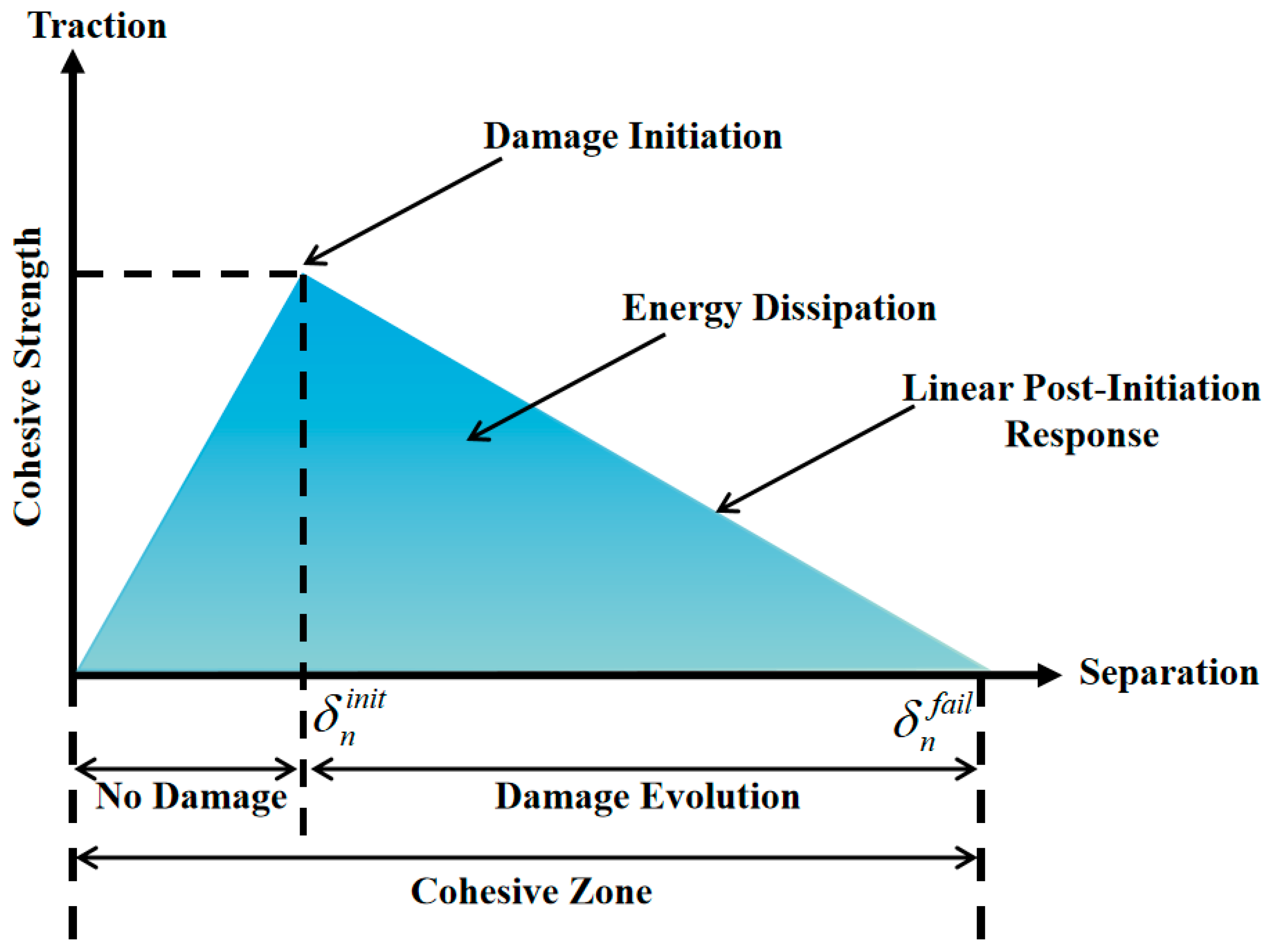
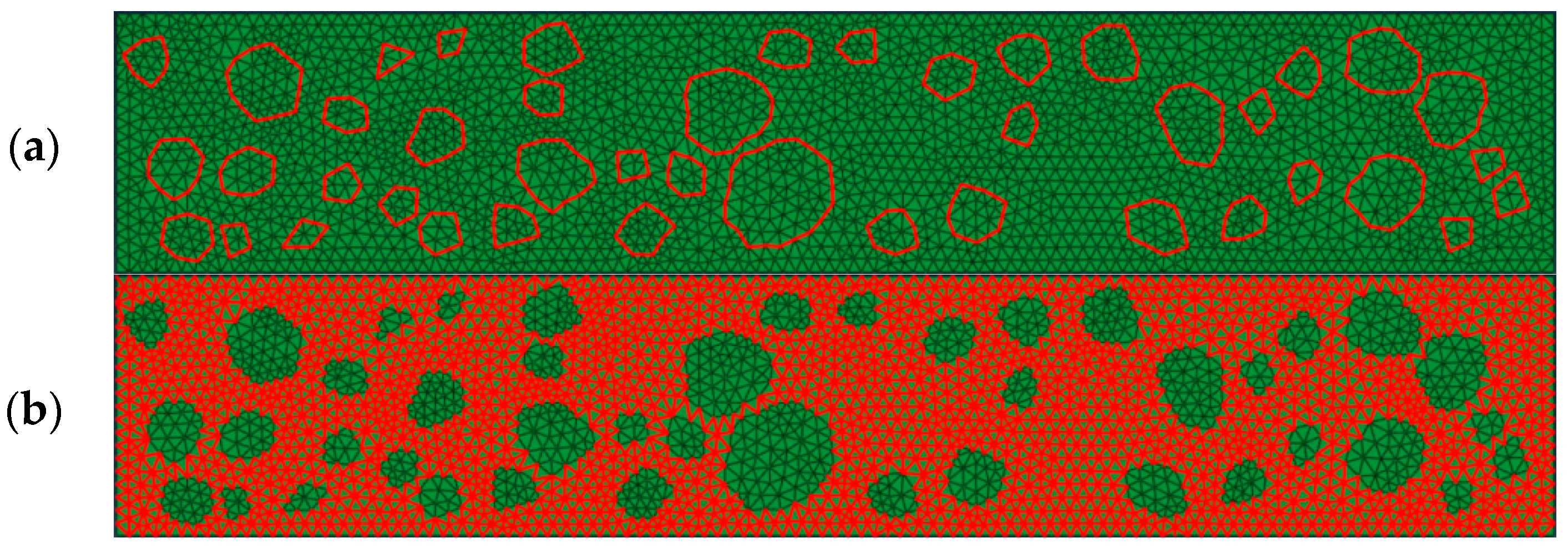



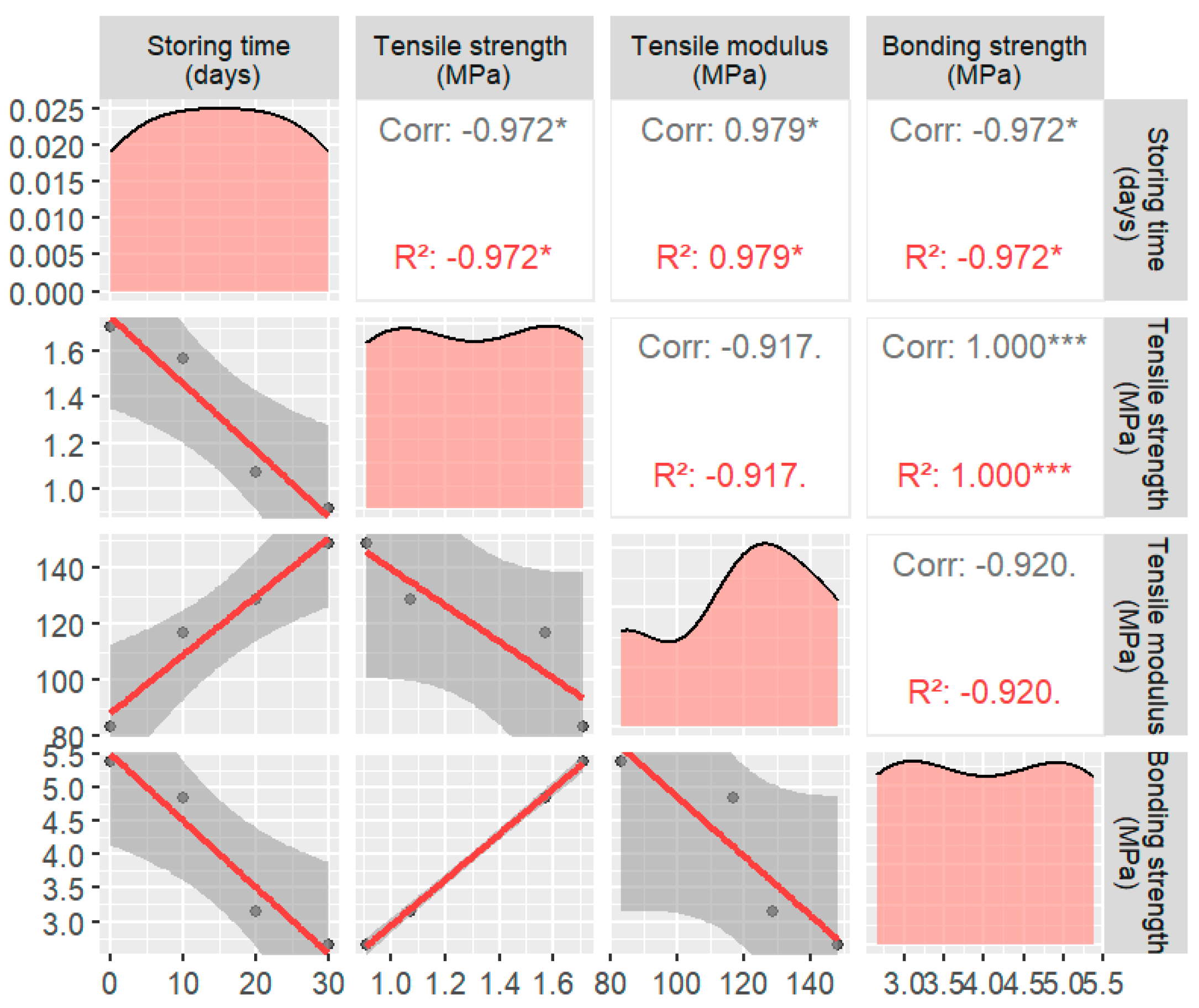
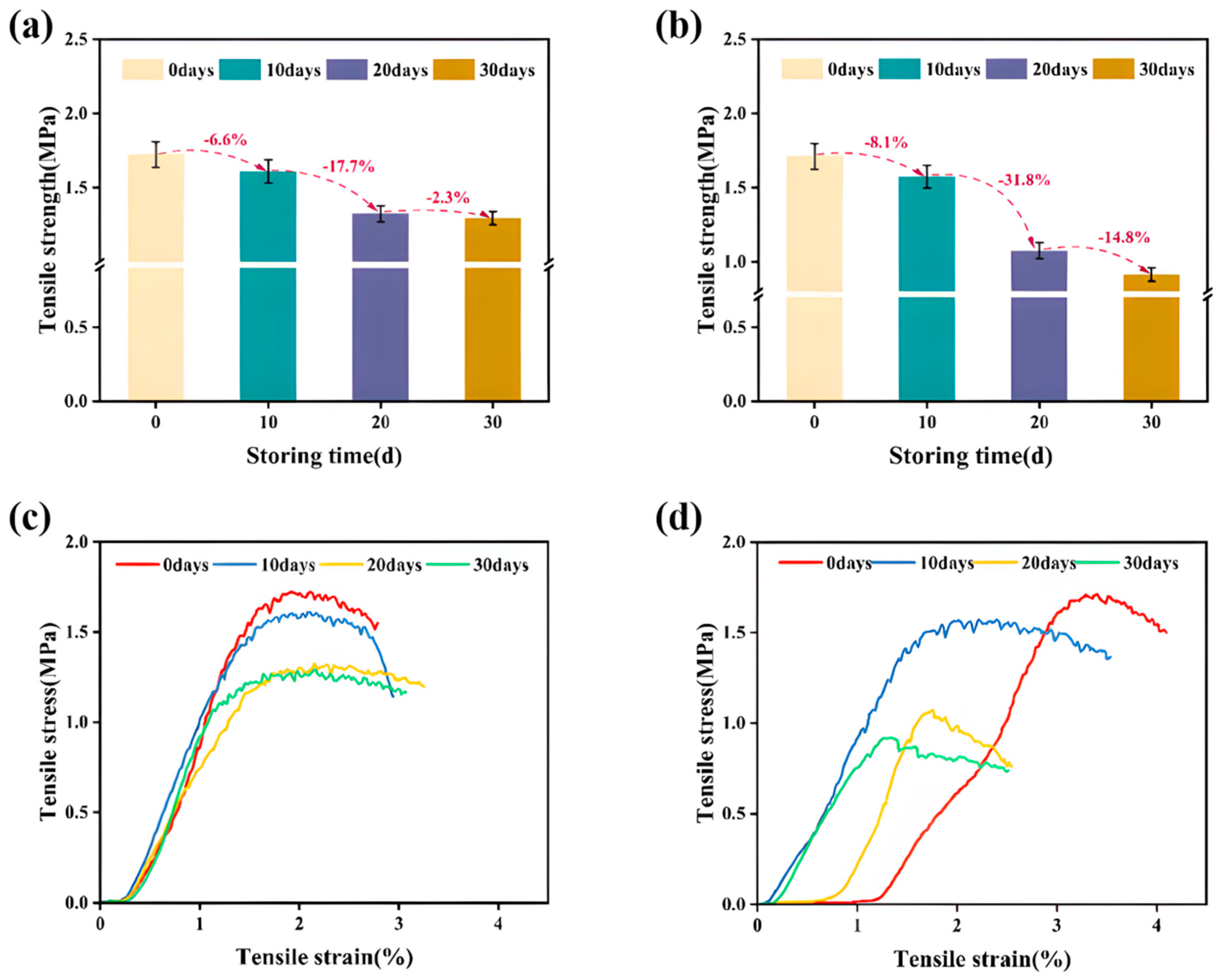

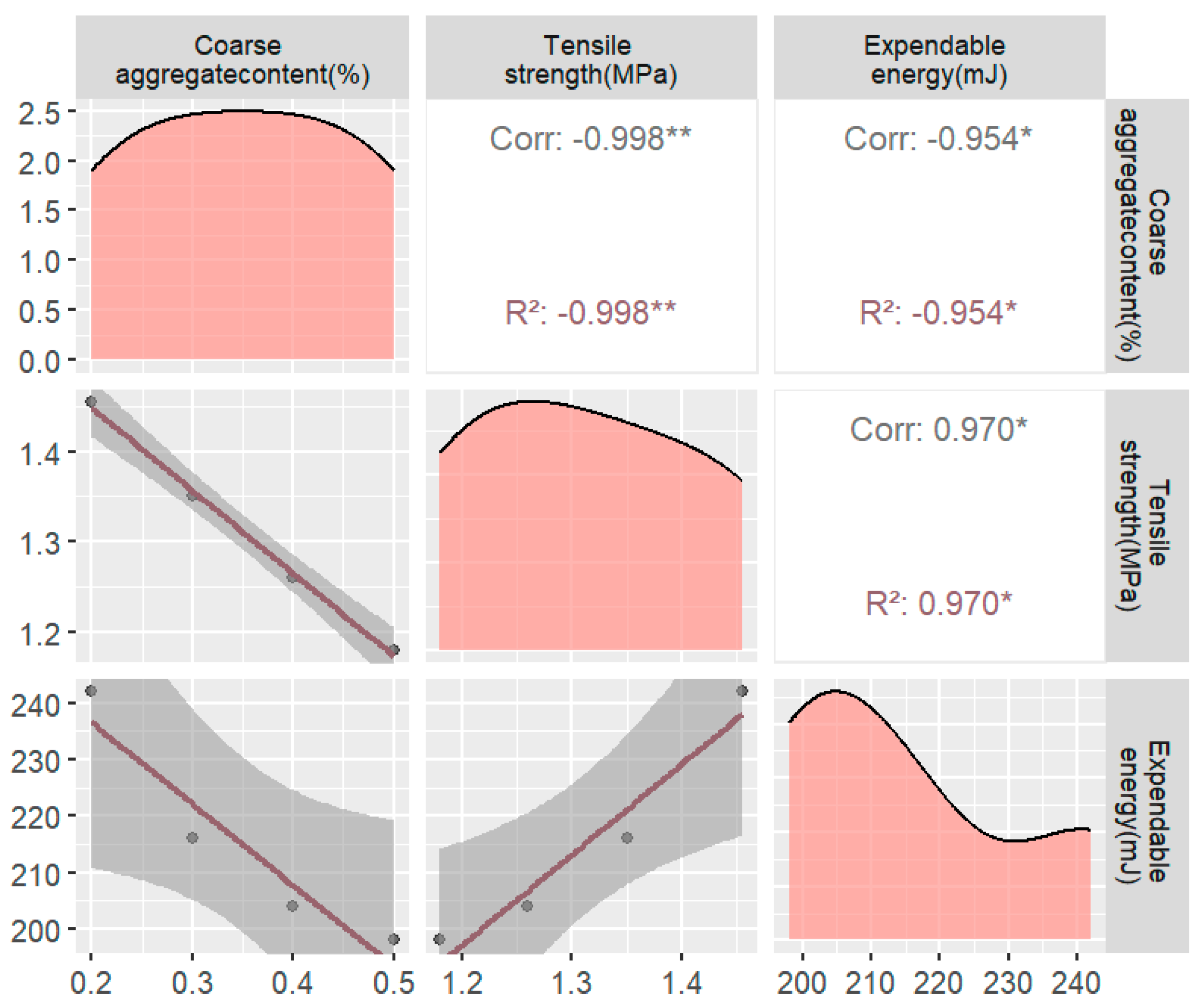
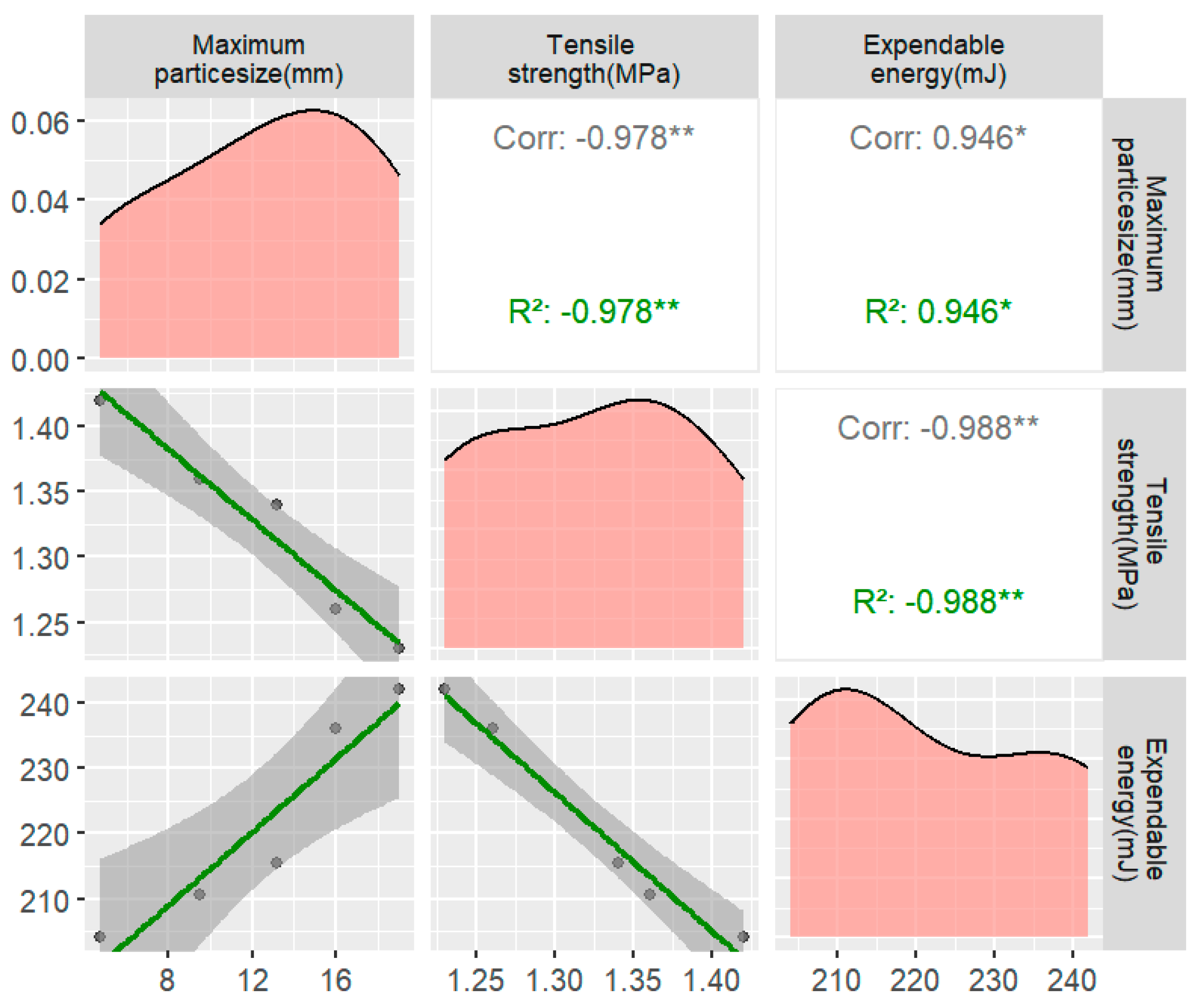
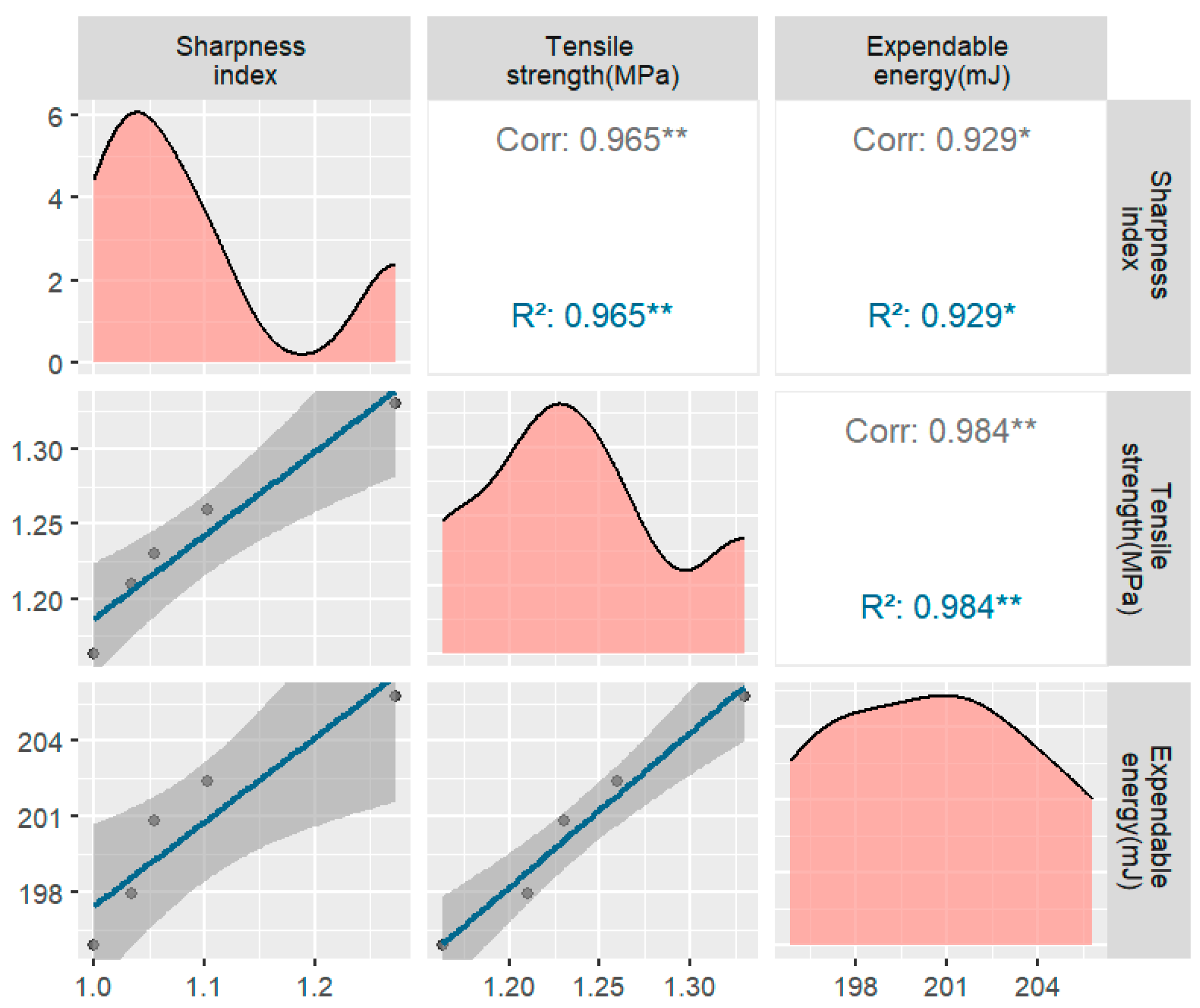
| Serial Number | Identification of Items | Unit | |
|---|---|---|---|
| 1 | Penetration (25 °C, 100 g, 5 s) | 1/10 mm | |
| 2 | Softening point (ring-and-ball test) | °C | |
| 3 | Ductility (10 °C, 5 cm/min) | cm | |
| 4 | Density (20 °C) | g/cm3 | |
| 5 | Bitumen film Heating test | Mass changes | % |
| Needle penetration ratio | % | ||
| Ductility (10 °C, 5 cm/min) | cm | ||
| Serial Number | Items | Unit | Design Requirements | Test Results |
|---|---|---|---|---|
| 1 | Apparent density | g/cm3 | ≥2.6 | 2.72 |
| 2 | Adhesion to asphalt | Level | ≥4 | 4 |
| 3 | Needle-flake particle content | % | ≤25 | 6.97 |
| 4 | Crushing value | % | ≤30 | 9.56 |
| 5 | Water absorption | % | ≤2 | 0.43 |
| 6 | Mud content | % | ≤0.5 | 0 |
| 7 | Durability (Na2 CO3 loss of mass in 5 dry and wet cycles) | % | ≤12 | 4.2 |
| Serial Number | Sports Event | Unit (of Measure) | Required Indicators | Test Results |
|---|---|---|---|---|
| 1 | Apparent density | g/cm3 | ≥2.55 | 2.71 |
| 2 | Water absorption | % | ≤2 | - |
| 3 | Water stability rating | classifier: step, level | ≥6 | 6 |
| 4 | Durability (loss of mass from 5 wet and dry cycles of sodium sulfate) | % | ≤15 | 1.2 |
| 5 | Stone powder content | % | <5 |
| Serial Number | Sports Event | Unit (of Measure) | Required Indicators | Test Results | |
|---|---|---|---|---|---|
| 1 | Apparent density | g/cm3 | ≥2.5 | 2.715 | |
| 2 | Moisture content | % | ≤0.5 | --- | |
| 3 | Hydrophilicity | --- | ≤1.0 | 0.628 | |
| 4 | Fine particulate degree (angles, temperature etc.) | <0.6 mm | % | 100 | 100 |
| <0.15 mm | >90 | 99.7 | |||
| <0.075 mm | >85 | 86.5 | |||
| Makings | Aggregate | Mortar (Building) | Asphalt Mortar–Asphalt Mortar | Asphalt Mortar–Coarse Aggregate |
|---|---|---|---|---|
| Modulus of elasticity (MPa) | 60,000 | 20,000 | - | - |
| Poisson’s ratio | 0.2 | 0.2 | - | - |
| Tensile strength (MPa) | - | - | 3.8 | 1.9 |
| Stiffness (MPa/mm) | - | - | 2.0 × 107 | 1.8 × 107 |
| Fracture energy (N/mm) | - | - | 0.09 | 0.045 |
| Storing Time (Days) | Tensile Strength (MPa) | Tensile Modulus (MPa) | Bonding Strength (MPa) |
|---|---|---|---|
| 0 | 1.71 | 83.24 | 5.38 |
| 10 | 1.57 | 116.91 | 4.85 |
| 20 | 1.07 | 128.77 | 3.15 |
| 30 | 0.91 | 148.57 | 2.66 |
| Specimen Type | Storing Time (d) | Intensity (g/cm3) | Maximum Tensile Strength Rtmax (MPa) | Strain at Maximum Tensile Strength εmax (%) | Tensile Modulus (MPa) |
|---|---|---|---|---|---|
| No anti-stripping agent | 0 | 2.423 | 1.711 | 2.80 | 83.24 |
| 10 | 2.417 | 1.573 | 3.17 | 116.91 | |
| 20 | 2.403 | 1.073 | 2.55 | 128.77 | |
| 30 | 2.389 | 0.914 | 1.45 | 148.57 | |
| Add SK-A anti-stripping agent | 0 | 2.425 | 1.723 | 2.79 | 85.39 |
| 10 | 2.421 | 1.609 | 2.94 | 113.79 | |
| 20 | 2.412 | 1.324 | 3.25 | 119.19 | |
| 30 | 2.401 | 1.294 | 3.41 | 146.46 |
Disclaimer/Publisher’s Note: The statements, opinions and data contained in all publications are solely those of the individual author(s) and contributor(s) and not of MDPI and/or the editor(s). MDPI and/or the editor(s) disclaim responsibility for any injury to people or property resulting from any ideas, methods, instructions or products referred to in the content. |
© 2024 by the authors. Licensee MDPI, Basel, Switzerland. This article is an open access article distributed under the terms and conditions of the Creative Commons Attribution (CC BY) license (https://creativecommons.org/licenses/by/4.0/).
Share and Cite
Bao, L.; He, M.; Wang, S.; Wu, X. Study on the Effect of Asphalt Static Conditions on the Tensile Properties of Acidic Aggregate Hydraulic Asphalt Concrete. Materials 2024, 17, 2627. https://doi.org/10.3390/ma17112627
Bao L, He M, Wang S, Wu X. Study on the Effect of Asphalt Static Conditions on the Tensile Properties of Acidic Aggregate Hydraulic Asphalt Concrete. Materials. 2024; 17(11):2627. https://doi.org/10.3390/ma17112627
Chicago/Turabian StyleBao, Lei, Min He, Shu Wang, and Xinshuang Wu. 2024. "Study on the Effect of Asphalt Static Conditions on the Tensile Properties of Acidic Aggregate Hydraulic Asphalt Concrete" Materials 17, no. 11: 2627. https://doi.org/10.3390/ma17112627
APA StyleBao, L., He, M., Wang, S., & Wu, X. (2024). Study on the Effect of Asphalt Static Conditions on the Tensile Properties of Acidic Aggregate Hydraulic Asphalt Concrete. Materials, 17(11), 2627. https://doi.org/10.3390/ma17112627









